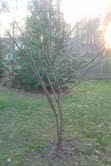This morning a white-throated sparrow
sat among the dried leaves on the forest floor.
It was chilly out, so it was puffed up into a perfectly round ball.
I studied its features through the binoculars:
Perfect black bars on its head. A white collar at its throat.
Yellow feathers near its eyes. Tawny streaks upon its breast.
The sparrow sat near a dove as both pecked at seeds
that had fallen from the feeder.
The dove departed.
The sparrow sat.
And sat.
And sat longer still.
Now the robin's song lilts from a distant tree,
the sparrow turns its head slightly to the left.
When the geese call from the lake,
the sparrow turns its head slightly to the right.
A blue jay squawks from above,
and the sparrow raises its head ever so slightly.
A squirrel jumps into a nearby feeder.
But sparrow still sits.
And sits.
And sits.
For more than 20 minutes,
the sparrow rests himself among the leaves, undisturbed.
The sparrow sits to the right of the second slate in the foreground.
I hadn't noticed the symmetry of the sparrow
and the pine cones along the slates until I saw the photo.
Our elegant universe perhaps.
<>





























